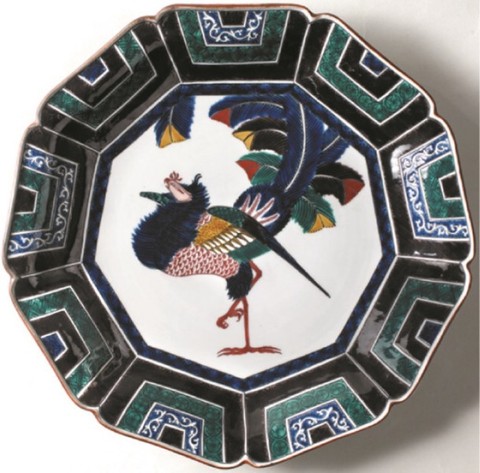
九谷の鉱山から陶石が発見されたことと、加賀藩の職人が、今の佐賀県有田町で磁器作りの技術を学んで来たことによって、17世紀の半ば頃、九谷の地で始められたのが古九谷焼(こくたにやき)です。古九谷は加賀百万石文化の、大らかさときらびやかさを合わせ持つ、独特の力強い様式美を作り上げましたが、17 世紀の終わり頃突然作られなくなってしまいました。その後、19世紀に入ると再び九谷焼が焼かれるようになりました。
それが再興九谷です。春日山窯の木米(もくべい)風、かつての古九谷の再興をめざした吉田屋窯、赤絵細描画の宮本窯、金襴手(きんらんで)の永楽(えいらく)窯等数多くの窯が現れ、それぞれ特有の画風を作り出し、九谷焼の産業としての地位を築きました。

The first porcelain to be produced in the Kutani area was in the 17th century, when a member of the Kaga clan, Goto Saijiro, who had studied the techniques of making porcelain in Arita in northern Kyushu, set up a kiln making Kokutani ware, a suitable porcelain clay having been discovered in the area. While Kokutani or "old Kutani" ware combined the generosity and splendor of the culture of the Kaga clan, it developed into a unique form of porcelain with a strength and boldness all its own. At the end of the 17th century, however, production suddenly ceased. Firing did not begin again until the beginning of the 19th century, when the revival of Kutani ware was produced. Many different kilns appeared each with their own unique design style helping to establish this production center. There was the Mokubei style of the Kasugayama kiln, the Yoshida kiln which tried to echo Kokutani ware, the fine drawing in red of the Miyamoto kiln and the red and gold highly figured designs of the Eiraku kiln.
The true intrinsic quality of Kutani is its multi-colored over-glaze enamel images. It is characterized by its use of heavily overlaid Japanese pigments, namely red, green, yellow, purple and prussian blue, and bold outlining. What is perhaps unique to Kutani is the way that the enamels appear even more brilliant because of the restrained coloring of its slightly bluish ground. Various piece of tableware are now made in a number of Kutani styles, along with flower vases, some ornaments and beautifully adorned sake flasks. The world famous porcelain is produced by 400 firms employing 1,800 staff, among whom there are 49 government recognized Master Craftsmen with the responsibility of heading this craft.